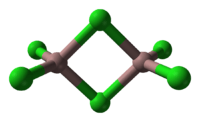Gallium trichloride
 | |
| Names | |
|---|---|
| Other names
Gallium(III) chloride, Trichlorogallium, Trichlorogallane | |
| Identifiers | |
| 13450-90-3 | |
| ChemSpider | 24229 |
| |
| Jmol-3D images | Image |
| PubChem | 26010 |
| RTECS number | LW9100000 |
| |
| UNII | 4Y6GQD4915 |
| Properties | |
| GaCl3 | |
| Appearance | colorless crystals deliquescent |
| Density | 2.47 g/cm3 2.053 g/cm3 at melting point |
| Melting point | 77.9 °C (172.2 °F; 351.0 K) (anhydrous) 44.4 °C (hydrate) |
| Boiling point | 201 °C (394 °F; 474 K) |
| very soluble | |
| Solubility | soluble in benzene, CCl4, CS2 |
| Hazards | |
| EU Index | Not listed |
| NFPA 704 | |
| Flash point | Non-flammable |
| LD50 (Median lethal dose) |
4700 mg/kg (rat, oral) |
| Related compounds | |
| Other anions |
Gallium(III) fluoride Gallium(III) bromide Gallium(III) iodide |
| Other cations |
Aluminium chloride Indium(III) chloride Thallium(III) chloride |
| Except where noted otherwise, data is given for materials in their standard state (at 25 °C (77 °F), 100 kPa) | |
| | |
| Infobox references | |
Gallium trichloride is the chemical compound with the formula GaCl3. Solid gallium trichloride exists as a dimer with the formula Ga2Cl6.[1] It is colourless and soluble in virtually all solvents, even alkanes, which is truly unusual for a metal halide. It is the main precursor to most derivatives of gallium and a reagent in organic synthesis.[2]
As a Lewis acid, GaCl3 is milder than aluminium trichloride. Gallium(III) is easier to reduce than Al(III), so the chemistry of reduced gallium compounds is more extensive than for aluminium. Ga2Cl4 is known whereas the corresponding Al2Cl4 is not. The coordination chemistry of Ga(III) and Fe(III) are similar, and gallium(III) compounds have been used as diamagnetic analogues of ferric compounds.
Preparation
Gallium trichloride can be prepared from the elements, heating gallium metal in a stream of chlorine, and purifying the product by sublimation under vacuum.[3][4]
- 2 Ga + 3 Cl2 → 2 GaCl3
It can also be prepared from the gallium oxide by heating with thionyl chloride:[5]
- Ga2O3 + 3 SOCl2 → 2 GaCl3 + 3 SO2
Structure
The dimeric structure involving two chlorine bridging atoms with the gallium atoms essentially tetrahedrally coordinated by chlorine is surprising, as the chlorides of the two members of group 13 above and below gallium, AlCl3 and InCl3 both contain 6 coordinate metal atoms in a three-dimensional structure. As a consequence of its structure where there are no significant lattice forces, gallium trichloride has the lowest melting point of all of the aluminium, gallium and indium trihalides. The formula of Ga2Cl6 is often written as Ga2(μ-Cl)2Cl4. In the gas phase the dimers dissociate to trigonal planar monomers.
Complexes
Gallium is the lightest member of Group 13 to have a full d shell, (gallium has the electronic configuration Ar 3d10 4s2 4p1) below the valence electrons that could take part in d-π bonding with ligands. The low oxidation state of Ga in Ga(III)Cl3, along with the low electronegativity and high polarisability, allow Ga(III)Cl3 to behave as a "Soft Acid" in terms of the HSAB theory. The strength of the bonds between gallium halides and ligands have been extensively studied. What emerges is:
- GaCl3 is a weaker Lewis acid than AlCl3 towards N and O donors e.g. pyridine
- GaCl3 is a stronger Lewis acid than AlCl3 towards thioethers e.g. dimethyl sulfide, Me2S
With a chloride ion as ligand the tetrahedral GaCl4− ion is produced, the 6 coordinate GaCl63− cannot be made. Compounds like KGa2Cl7 that have a chloride bridged anion are known[6] In a molten mixture of KCl and GaCl3, the following equilibrium exists:
- 2 GaCl4−
 Ga2Cl7− + Cl−
Ga2Cl7− + Cl−
Use in detection of solar neutrinos
110 tons of gallium trichloride aqueous solution was used in the GALLEX and GNO experiments performed at Laboratori Nazionali del Gran Sasso in Italy to detect solar neutrinos. In these experiments, germanium-71 was produced by neutrino interactions with the isotope gallium-71 (which has a natural abundance of 40%), and the subsequent beta decays of germanium-71 were measured.[7]
See also
References
- Greenwood, Norman N.; Earnshaw, Alan (1997). Chemistry of the Elements (2nd ed.). Butterworth-Heinemann. ISBN 0080379419.
- "Gallium". WebElements Periodic Table.
- ↑ Wells, A.F. (1984) Structural Inorganic Chemistry, Oxford: Clarendon Press. ISBN 0-19-855370-6.
- ↑ Yamaguchi, M.; Shibasaki, M. Gallium Trichloride" in Encyclopedia of Reagents for Organic Synthesis 2005; John Wiley & Sons. doi:10.1002/047084289X.rn00118u
- ↑ S.C. Wallwork I.J.Worral J.Chem. Soc 1965,1816
- ↑ Kovar, R. A. "Gallium Trichloride" Inorganic Syntheses, 1977, volume XVII, pp 167-172. ISBN 0-07-044327-0
- ↑ H.Hecht, G.Jander, H.Schlapmann Z. Anorg. Allgem. Chem. Vol.254, p.255 (1947)
- ↑ J H von Barner Inorg Chem 1985 24 1686
- ↑ David R. Lide, ed. Handbook of Chemistry and Physics, 85th Edition, Internet Version 2005. CRC Press, 2005.
External links
- "Emergency First Aid Treatment Guide - Gallium Trichloride". United States Environmental Protection Agency.
| ||||||
